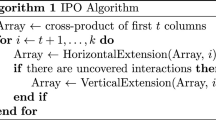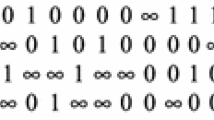Abstract
Covering arrays can be applied to the testing of software, hardware and advanced materials, and to the effects of hormone interaction on gene expression. In this paper we develop constraint programming models of the problem of finding an optimal covering array. Our models exploit global constraints, multiple viewpoints and symmetry-breaking constraints. We show that compound variables, representing tuples of variables in our original model, allow the constraints of this problem to be represented more easily and hence propagate better. With our best integrated model, we are able to either prove the optimality of existing bounds or find new optimal solutions, for arrays of moderate size. Local search on a SAT-encoding of the model is able to find improved solutions and bounds for larger problems.
Similar content being viewed by others
References
Bacchus, F., & van Beek, P. (1998). On the conversion between non-binary and binary constraint satisfaction problems. Proceedings of the 15th National Conference on Artificial Intelligence, AAAI 98 (pp. 311–318).
Bryce, R., Colbourn, C., & Cohen, M. (2005). A framework of greedy methods for constructing interaction tests. The 27th International Conference on Software Engineering (ICSE 2005) (pp. 146–155).
Cha, B., & Iwama, K. (1996). Adding new clauses for faster local search. In Proceedings of the 13th National Conference on Artificial Intelligence, AAAI 96, Vol. 1 (pp. 332–337).
Chateauneuf, M., & Kreher, D. (2002). On the state of strength-three covering arrays. J. Comb. Des. 10(4), 217–238.
Cheng, B. M. W., Choi, K. M. F., Lee, J. H. M., & Wu, J. C. K. (1999). Increasing constraint propagation by redundant modeling: An experience report. Constraints 4, 167–192.
Cohen, D. M., Dalal, S. R., Fredman, M. L., & Patton, G. C. (1997). The AETG system: an approach to testing based on combinatorial design. IEEE Trans. Softw. Eng. 23(7), 437–444.
Cohen, D. M., Dalal, S. R., Parelius, J., Patton, G. C. (1996). The combinatorial design approach to automatic test generation. IEEE Software 13(5), 83–88.
Cohen, M. B., Gibbons, P. B., Mugridge, W. B. & Colbourn, C. J. (2003). Constructing test suites for interaction testing. ICSE ’03: Proceedings of the 25th International Conference on Software Engineering, (pp. 38–48). IEEE Computer Society.
Colbourn, C. J., Cohen, M., & Turban, R. (2004). A deterministic density algorithm for pair wise interaction coverage. The IASTED International Conference on Software Engineering (pp. 242–252).
Colbourn, C. J. (2005) Combinatorial aspects of covering arrays. Le Matematiche (Catania), to appear.
Dechter, R., & Pearl, J. (1989). Tree clustering for constraint networks. Artif. Intell. 38, 353–366.
Flener, P., Frisch, A., Hnich, B., Kiziltan, Z., Miguel, I., Pearson, J., & Walsh, T. (2002). Breaking row and column symmetry in matrix models. In P. van Hentenryck, (Ed.), Principles and Practice of Constraint Programming - CP-2002), LNCS 2470 (pp. 462– 476). Springer.
Flener, P., Frisch, A., Hnich, B., Kiziltan, Z., Miguel, I., & Walsh, T. (2002). Matrix modelling: exploiting common patterns in constraint programming. In A. Frisch, (Ed.), Proceedings of the International Workshop on Reformulating Constraint Satisfaction Problems (pp. 27–41).
Frisch, A., Hnich, B., Kiziltan, Z., Miguel, I., & Walsh, T. (2002). Global constraints for lexicographic orderings. In P. van Hentenryck, (Ed.), Principles and Practice of Constraint Programming—CP-2002, LNCS 2470 (pp. 93–108). Springer.
Gent, I. P., & Walsh, T. (1995). Unsatisfied variables in local search. In J. Hallam, (Ed.), Hybrid Problems, Hybrid Solutions (pp. 73–85). IOS Press.
Hartman, A., & Raskin, L. (2004). Problems and algorithms for covering arrays. Discrete Math. 284(1–3), 149–156.
Hnich, B., Prestwich, S. D., & Selensky, E. (2005). Constraint-based approaches to the covering test problem. In B. Faltings, A. Petcu, F. Fages, & F. Rossi, (Eds.), Recent Advances in Constraints, Joint ERCIM/CoLogNet International Workshop on Constraint Solving and Constraint Logic Programming, CSCLP 2004, LNCS 3419 (pp. 172–186). Springer.
Kask, K., & Dechter, R. (1995). GSAT and local consistency. In C. Mellish, (Ed.), Proceedings of the 14th International Joint Conference on Artificial Intelligence, IJCAI 95 (pp. 616–622).
Lei, Y., & Tai, K. C. (1998). In-parameter-order: a test generation strategy for pairwise testing. In Third IEEE International High-Assurance Systems Engineering Symposium (pp. 161–254).
Meagher, K., & Stevens, B. (2005). Group construction of covering arrays. J. Comb. Des. 13(1), 70–77.
Kobayashi, N. (2002). Design and Evaluation of Automatic Test Generation Strategies for Functional Testing of Software. PhD thesis, Osaka University.
Nurmela, K. (2004). Upper bounds for covering arrays by Tabu search. Discrete Appl. Math. 138, 143–152.
Prestwich, S. (2003). Negative effects of modeling techniques on search performance. Ann. Oper. Res. 118, 137–150.
Régin, J. (1996). Generalized arc consistency for global cardinality constraints. Proceedings of the 13th National Conference on Artificial Intelligence, AAAI 96, (pp. 209–215). AAAI Press/The MIT Press.
Rényi, A. (1971). Foundations of Probability. Wiley.
Selman, B.,Kautz, H. A., & Cohen, B. (1994). Noise strategies for improving local search. Proceedings of the 12th National Conference on Artificial Intelligence, AAAI 94, Vol. 1 (pp. 337–343).
Selman, B., Levesque, H., & Mitchell, D. (1992). A new method for solving hard satisfiability problems. Proceedings of the 10th National Conference on Artificial Intelligence, AAAI 92 (pp. 440–446).
Seroussi, G., & Bshouty, N. (1988). Vector sets for exhaustive testing of logic circuits. IEEE Trans. Info. Theory IT-34, 513–522.
Sloane, N. J. A. (1993). Covering arrays and intersecting codes. J. Comb. Des. Vol. 1, 51–63.
Smith, B. M. (2002). A dual graph representation of a problem in ‘Life.’ In P. van Hentenryck (Ed.), Principles and Practice of Constraint Programming—CP-2002, LNCS 2470 (pp. 402–414). Springer.
Tung, Y.-W., & Aldiwan, W. (2000). Automating test case generation for the new generation missionsoftware system. Proceedings IEEE Aerospace Conference, Vol. 1 (pp. 431–437).
Williams, A. W. (2000). Determination of test configurations for pair-wise interaction coverage. Proceedings of the 13th International Conference on the Testing of Communicating Systems (TestCom 2000) (pp. 59–74).
Author information
Authors and Affiliations
Corresponding author
Rights and permissions
About this article
Cite this article
Hnich, B., Prestwich, S.D., Selensky, E. et al. Constraint Models for the Covering Test Problem. Constraints 11, 199–219 (2006). https://doi.org/10.1007/s10601-006-7094-9
Published:
Issue Date:
DOI: https://doi.org/10.1007/s10601-006-7094-9




